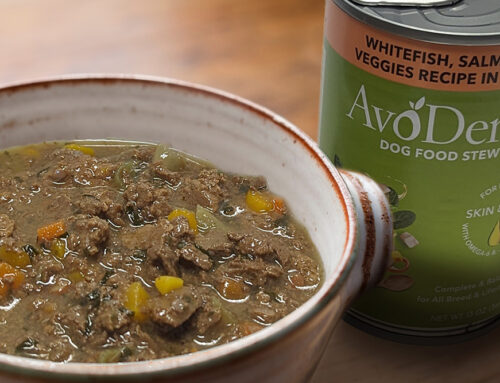One of the greatest responsibilities we have as dog owners is choosing the right food for our pets. There are a lot of considerations: meals need to be digestible, palatable, and must provide a wide range of nutrients. One of the easiest ways to ensure that your dog is receiving everything he needs in a food to keep him in optimum condition is to adopt a revolving diet.
Revolving Diet 101
A revolving diet, also known as a rotational diet, is all about taking a well-balanced approach to your dog’s diet. Instead of feeding him the same food every day, rotate recipes so your dog gets a range of proteins into his diet. This can help reduce the likelihood of your dog developing food sensitivities. The recipes should complement each other in terms of their nutritional qualities so that you can switch without giving your dog digestive issues.
The More Nutrients and Proteins, the Better
Natural, premium dog foods are carefully formulated to provide balanced meals; each recipe contains quality ingredients that have unique nutritional characteristics. But if you continually provide only one variety, your dog misses out on other nutrients and protein sources beneficial to its well-being.
For example, the vitamins, minerals, amino acids and fatty acids found in recipes where duck is the main ingredient are different than those found in a trout-based meal. While each recipe provides a balanced range of nutrients on their own, when eaten as part of a revolving diet, your dog enjoys a more diverse and complete range of nutrients from a wider variety of sources. The more nutrients your dog gets, the better for his health.
A revolving diet that makes use of recipes that are designed to work together is ideal. Recipes that complement each other nutritionally allow you to create a meal plan that is optimized to the unique needs of your dog and beneficial for his long-term health and happiness.
Reduction of Food Sensitivities
Food sensitivities are any adverse reactions that can result from a dog’s ability to digest particular types of food.1 Food sensitivities can be associated with any ingredient, but are most often caused by beef, chicken, milk, eggs, maize, wheat and soya bean.2
One of the most common causes of food sensitivities in dogs is eating too much of a particular type or improperly formulated food over time.1 In fact, dogs can eat a food without incident for more than two years prior to showing symptoms.2 Food sensitivity often arises spontaneously and presents in the form of digestive issues, such as vomiting and diarrhea, or skin irritations and even hair loss, which can be distressing for your dog and for you.
The best way to combat these symptoms is by switching to a diet that features sources of protein that the dog has not eaten recently. These protein sources must also be free of lactose and gluten1. Adopting a revolving diet that features a range of similar recipes with complementary protein sources will help a previously sensitive dog to thrive.
Beginning a Revolving Diet
Choosing to begin a revolving diet using AvoDerm Revolving Menu recipes is a great starting point. AvoDerm formulas are designed to work together to offer a greater variety of nutrients that help support healthy digestion and can help minimize food sensitivity issues. A complete, well-rounded meal plan can include both wet and dry foods that offer a combination of protein sources, including duck, turkey, trout or lamb.
It’s best to transition dogs to new food over a period of five days so as to not disturb their digestive pattern. Once you’ve successfully trialed a few recipes, switch them every one to three months to get the maximum benefits of the revolving diet.
A good diet and proper nutrition is paramount to your dog’s health and quality of life. Making a commitment to feed him a high quality, well-rounded diet will help him remain happy and healthy for life.
SOURCES:
- Watson, T.D.G. (1998) Diet and Skin Disease in Dogs and Cats. The Journal of Nutrition. 128 (12).
- Day, M.J. (2005) The canine model of dietary hypersensitivity. Proceedings of the Nutrition Society. 64, 458-464





